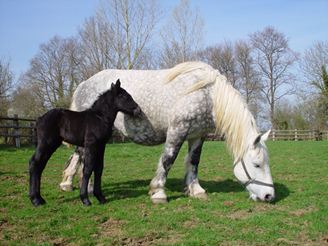Our horses
The Percheron
History
The origin of Percheron goes back centuries, and it was already established well before the Middle Ages. The breed originated in the Perche region of Normandy, and it takes it's name from this region. Cross breeding in the 19th century with Arab stallions have led to the saying, "The Percheron is an Arab horse made fat by the climate and the hardiness of the services for which it has been employed for centuries".
The breed
Percheron foals are always born black, then after 6 months, they either stay black or go dapple gray and then turn white as they get older, which is a trait said to come from their Arab heritage.
It is very versatile horse, used for farm work, in harness, and also as a riding mount, and has a very calm temperament. Its gait is lively and ample, which distinguishes it from other draught breeds. They measure from 1.55m to 1.85m (15.5 - 18 hands) at the withers
The Percheron at the Haras
The Haras national du Pin has a fine herd of both black and gray Percherons, including Spectacle Fauvellière and Echo de Vanoise. We have a Valorisation Centre at the Haras which helps promote the Normandy breeds the Percheron, the Norman Cob, and the Normandy and Cotentin donkeys. Local breeders entrust their young horses and donkeys to the Centre, in order to advance their education, and find a buyer in due course.
The Norman Cob

History
The Norman Cob is from the Manche region of Normandy, and was widely used as a light draught horse in the 19th century. It was also used in the First World War as an artillery horse.
The Breed
The Norman Cob is a versatile and light draft horse, with a manoeuvrable and dynamic size (600-800kg) and an elegant gait. It is a horse with a good temperament, used in harness and also under saddle for leisure, competition, trekking, agricultural or town use, such as the collection of waste.
The Norman Cob at the Haras
You may see young Norman Cobs being broken in at the Valorisation Centre
The Selle Français
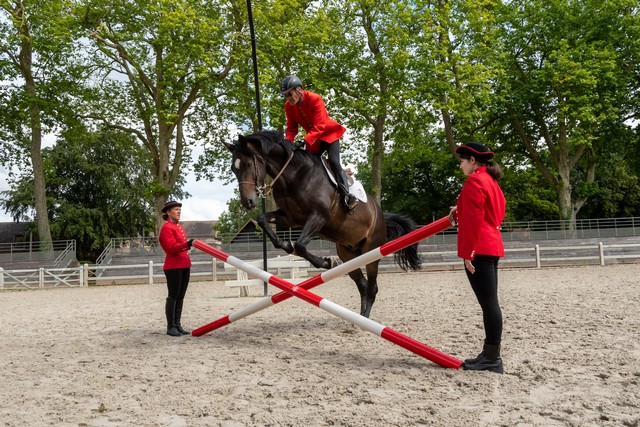
At the stud: Ultra Maugrey is a bay Selle Français born in 2008. He is a classy horse resulting from the crossing of the agile Quite Easy and the important Camargo. He is mainly a show jumping horse.
The History
The most famous of the Haras du Pin stallions is the Thoroughbred, Furioso, imported from England in 1946, and who died of heart failure on September 3, 1967, after having completed 22 breeding seasons, and covering 558 mares. Thanks to the crossbreeding with Norman mares and through his stallion descendants who had spread throughout Europe, he is credited with being the originator of the modern show jumping horse, and a founding element of the Selle Français horse breed.
The Breed
The Selle Français is the result of 19th century crosses between English Thoroughbreds and local Norman mares. The breed was known as the Anglo-Norman half-blood before WW2, and from 1958, it was called the Selle Français. From this point onwards, it continued to improve through various crosses and selection for sporting ability. One of the strongest and most versatile of the European competition breeds, the Selle Français is very adaptable, especially in eventing and show jumping. They have great jumping abilities, and measure between 1.65m to 1.70m at the withers (15 - 16 hands). Initially a French breed, the Selle Francais is now known internationally.
The Selle Francais at the Haras
Ultra Maugrey is a bay Selle Français, born in 2008. He is a good looking horse, born from the breeding between the agile Quite Easy and the well known Camargo. He is an excellent show jumper.
The Miniature Horse
History
At the end of the 19th century, a number of small English and Dutch horses were exported to the USA and used in the coal mines of the Appalachians until the 1950s.
The Miniature Horses Stud Book was created in 1978, and the breed became standard.
The "Minis" are now widespread throughout the world, especially in North and South America, Britain and the Netherlands.
The Breed
The Miniature Horse is known as the perfect and smallest possible reduction of a regular horse. It can be any breed of horse, provided it conforms to the breeds standard.
Often described as “A big horse in a small package”, the miniature horse is powerful, elegant, and agile. They must measure less than 86cm (8.2 hands) at the withers. They have very kind natures.
The Miniature Horse at the Haras
Plume is a male Miniature horse measuring 85cm at the withers, and weighing approximately 100 kg. He often takes part in our shows, and is able to jump through a hoop, rear up or play soccer with a big ball. He is very endearing due to his small size, and he also participates in educational activities with school groups.
The Shetland

The History
In the 19th century, Shetland ponies were widely used on farms, and also in coal mines. During the 20th century, their use has spread to leisure activities, especially for children, as they were made popular by the British Royal Family. Today they are generally used as mounts for young children, or used as in teams for carriage driving.
The Breed
The Shetland is originally from the Scottish archipelago that bears its name, located between Scotland and Norway, in the middle of the North Sea.
The first evidence ponies on the Shetland Islands dates back to the Bronze Age, and there are several theories as to how the ponies ended up on these isolated islands. The most probable is that the horses of the Eurasian Steppes could have arrived there during the ice age. There is also a theory that Spanish or Arab horses were stranded there after being shipwrecked during the Crusades. This would explain the presence of gray ponies on some islands. In addition, the Norwegian breeds of horses most certainly influenced the Shetland as we know it today, because during the Middle Ages there was already well established trade between Norway and the Shetland Islands.
Its small size can be explained by the climate and the particularly hostile environment found these islands.
The Stud Book permits all colours within the breed, except Appaloosa.
The Shetlands at the Haras
The Shetland is very endearing due to its small size. We have a herd of Shetland ponies at the Haras, and they are used for educational activities such as care, pony grooming, and pony rides with children and school groups.
The Welsh
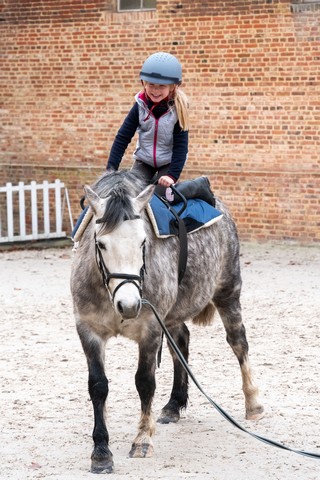
History
The Welsh Pony originates from Wales. Its evolution is unclear, but it is probably descended from Celtic ponies. At the time of Julius Caesar, the Romans crossed oriental horses with these local horses. The Welsh pony almost disappeared during the 16th century as a Royal edict ordered the slaughter of all horses not exceeding a certain size. Fortunately the Welsh pony survived hidden in the mountains.
The breed
The Welsh is a pony that can measure between 1.22m and 1.48m (12 - 14.2 hands), and weighs around 200 to 450kg.
It is ideal for sporting disciplines, as it is brave, intelligent and has exceptional gaits. In addition, the Welsh are superb showjumping ponies. They are also often used in carriage driving teams, and can equally be just a family pony. The breed is split into four categories of height, from Welsh A to Welsh Cob, so both children and adults can find a model that suits their size.
The Welsh at the Haras
E-Freeze is a Welsh pony born in 2014. This pony was the first foal to be born in Europe following a frozen embryo transfer.
The Spanish (PRE) Horse
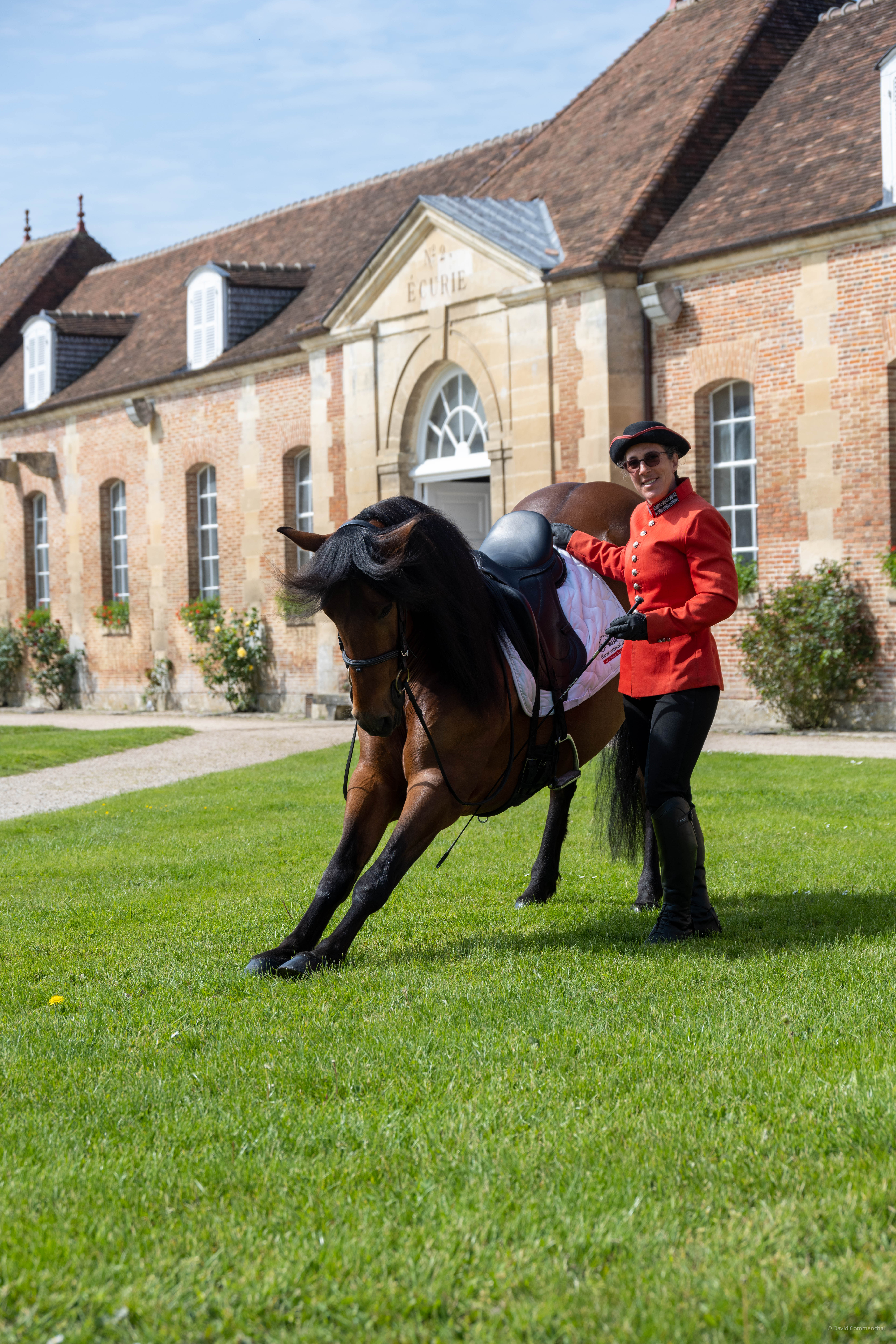
History
An ancient breed from Andalusia, in the south of Spain. It has been used for centuries for Haute Ecole riding, and this heritage is carried on by the Royal Andalusian School of Equestrian Art.
They are branded on the left thigh.
The breed
The pure bred Spanish horse has a compact body, a thick neck and a very elegant appearance. This breed is sought after for competitive dressage up to the highest level. It an also be used for carriage driving, the circus, and equestrian spectacles. The quality of his gait and his good temperament means that these horses are often used for film work. It is a classic riding horse that measures around 1m60 (15.2 hands) and can weigh between 350 to 550kg. It is often gray in colour, but all coats are accepted.
The Spanish Horse at the Haras
Limonero is a PRE stallion born in 2016.
The Selle Francais Pony
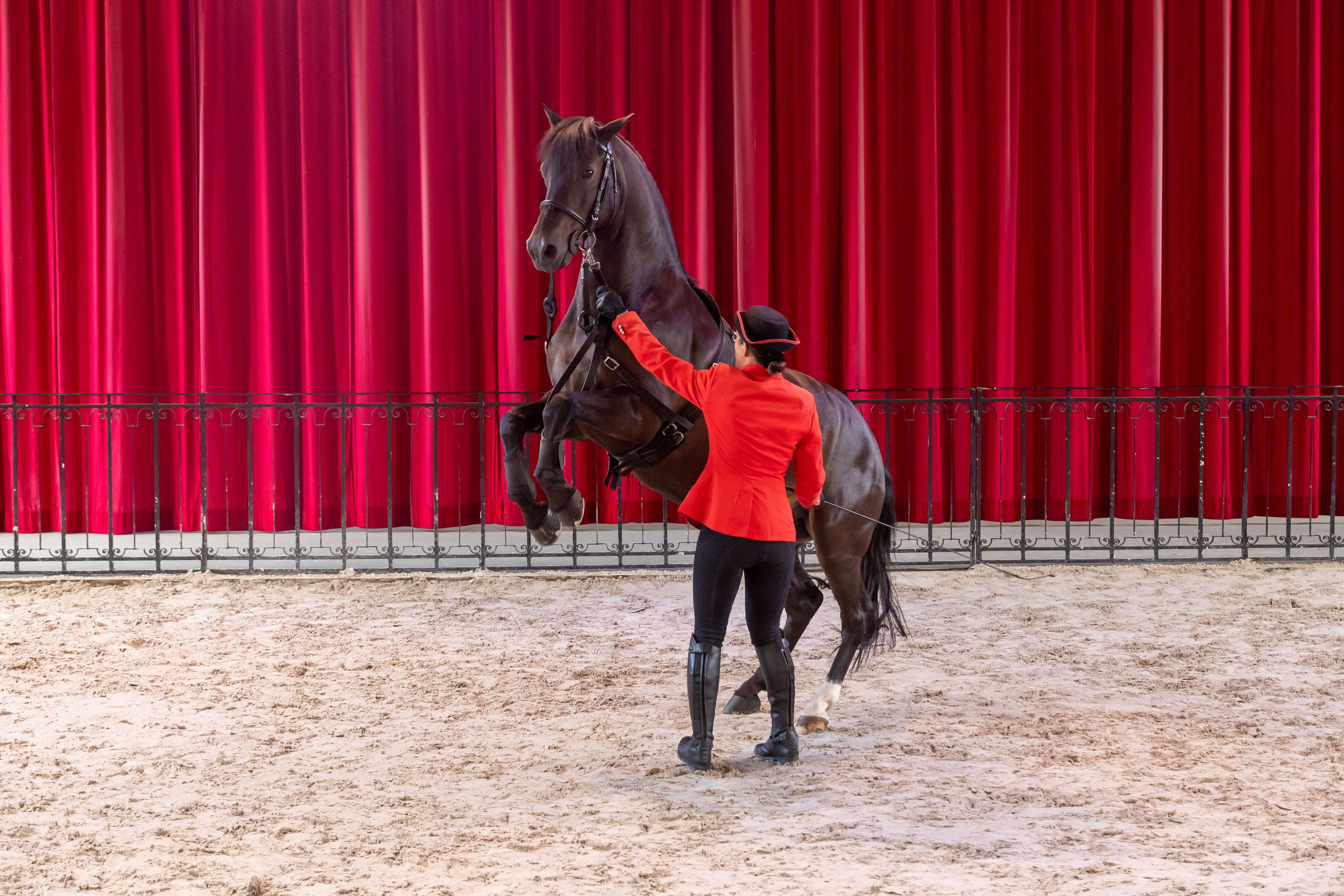
History
This is a recent French pony breed, known from 1991 onwards, created to meet the needs of young riders wanting mounts adapted to their size. Developed originally by crossing native ponies with Connemara, New Forest, Welsh and Arabian stallions.
The breed
The French saddle pony must look like a small horse: a sport pony used in show jumping, eventing, dressage and leisure.
The Selle Francais Pony at the Haras
Thanos de la Tour is a very versatile pony, who has competed in dressage, show jumping and cross country - he competed in the French pony show jumping championship. Today he is stabled with the show horses, and he brings a new set of skills to our equestrian spectacles.

 Français
Français

